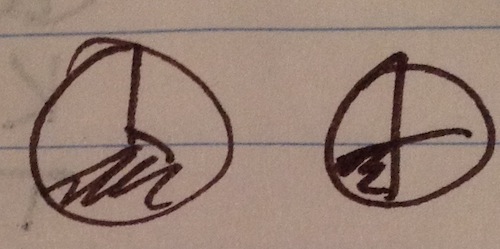The dirty little secret about Legos is how very many pieces there are to be cleaned up after building. And how very ugly the clean-up battle can become.
I try to keep calm. I try to turn the clean-up battle into math talk from time to time.
Here is how it played out a while back, when Griffin was 7 years old (nearly 8).
—
I send Griffin upstairs to clean up a big Lego mess. A while later, he returns.
Me: Did you pick those Legos up?
Griffin (7, nearly 8 years old): Yes. Well…not all of them.
Me: What fraction did you pick up? More or less than half?
G: Three fourths. No. One fourth. No….I’d say one third.
One third is more than one fourth.
Me: How do you know that?
Griffin draws a picture like the one below.
G: You see that it’s bigger.
Me: OK. Do want to hear how I know it’s bigger?
G: Yeah. How?
Me: If we had one big cookie and I had to share it with three people or share it with four people, I’d get more if I only shared with three.
G: Yeah.
Me: Which is bigger: three fourths, or two thirds?
He draws a picture like the one below (the original is lost to history).
G: Three fourths is.
Me: How do you know?
G: [referring to his picture]: It would be here [indicating the heavy line pointing to the lower left] if it were two thirds, and there’s more shaded in, so three fourths is bigger.
So what do we learn?
It seems to be easier to engage children in comparisons than in precise computations. I have a lot more success with Which is more? questions than I do with Exactly how much/how many? questions. This is especially true with fractions, where precise computations are often quite tedious.
In any case, the simple follow up question, How do you know that? is a powerful one. That is where the conversation happens nearly every time.
At this point Griffin is accustomed to being asked this question, which means he is pretty good at doing so. It seems natural to talk about how he knows something. If you are just starting these conversations with your own child, expect to have to ask on 10 or 15 separate occasions before it starts to become natural for them. This is just like introducing a new food. Repeated exposure is key.
Starting the conversation
This is classic lemonade-from-lemons parenting. I knew Griffin would not have completed his assigned task. We could fight about it, or we could talk about it. I chose to talk about it, and save the power struggle for a bit later.
You can do the same. What fraction dressed are you? What fraction of your teeth did you brush? How much of your body was touched by soap? Et cetera. Have a little fun with the math first. Then make them finish the job.


